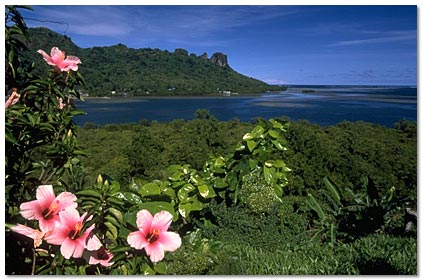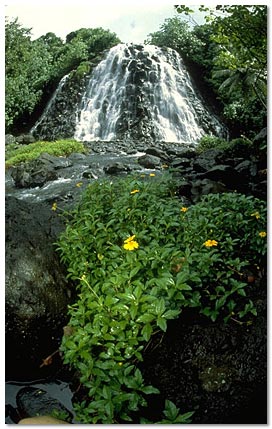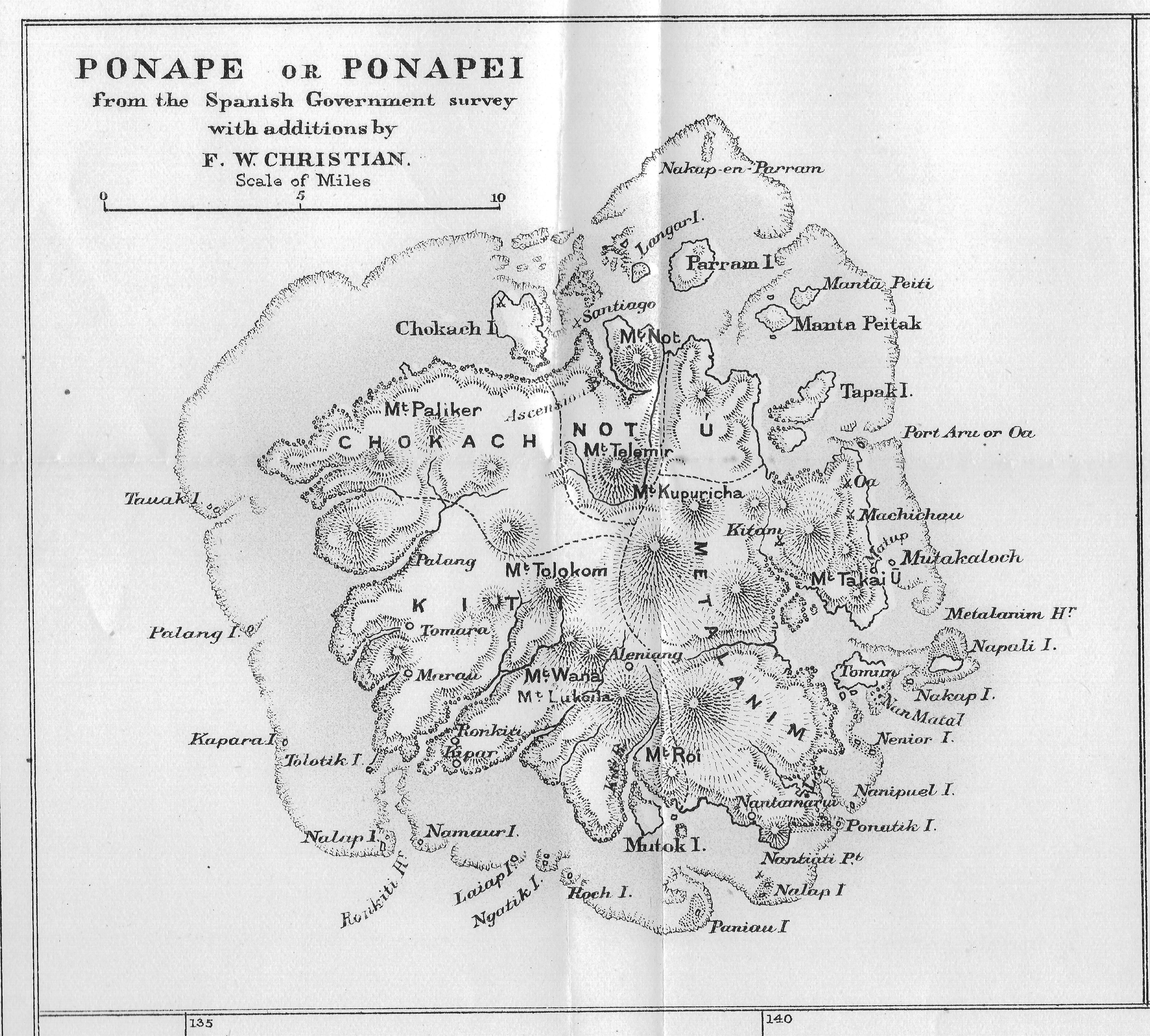ECW Weekender: The Farthest Battlefield—CSS Shenandoah at Pohnpei

This Civil War site is a paradisiacal place to pass a weekend—if you can get there.
 April fool’s day, 1865: In the misty glow of dawn, soaring emerald peaks sprouted from azure seas as the CSS Shenandoah, last of the Confederate commerce raiders, approached the Island of Pohnpei in the western Pacific. Luxuriant tropical foliage spilled to the water’s edge. Lieutenant Francis Chew of Missouri marveled at this mingling of green and bright aquamarine, which gave, “a cool refreshing appearance to the harbor.”[i] Four Yankee whalers lay at anchor.
April fool’s day, 1865: In the misty glow of dawn, soaring emerald peaks sprouted from azure seas as the CSS Shenandoah, last of the Confederate commerce raiders, approached the Island of Pohnpei in the western Pacific. Luxuriant tropical foliage spilled to the water’s edge. Lieutenant Francis Chew of Missouri marveled at this mingling of green and bright aquamarine, which gave, “a cool refreshing appearance to the harbor.”[i] Four Yankee whalers lay at anchor.
Shenandoah captured and burned the whalers; their bones still lie on the bottom of Lohd Pah Harbor. It is today a quiet place, virtually unused and unchanged from the nineteenth century, visited only by the occasional fishing canoe or small boat. The young officers of Shenandoah were fascinated by the island and by the exotic warrior culture they encountered, which seemed totally alien but was more like them than they knew.
Rising out of the ocean nearly on the equator and opposite London on the globe, thousands of miles from anywhere, Pohnpei is now the capital of the Federated States of Micronesia. The Federated States—independent since 1986 in free association with the United States—claims six hundred islands scattered like emeralds across one and a half million square miles of the bluest water in the Pacific. An ocean area two-fifths the size of the U.S. mainland contains a land area about a quarter of the size of Rhode Island.
Pohnpei presents a striking contrast to the many low-lying coral atolls dotting the Pacific. It is the tip of an extinct volcano, fourteen miles across, a roughly circular 277 square miles of black basalt rock dissected by eleven mountains over two thousand feet high. Steep ridges and deep valleys cascade outward and downward to a shoreline with little coastal plain.
 Imposing peaks rake moisture from heavy clouds engorging more than forty rivers tumbling over ethereal waterfalls into quiet pools shaded by emerald forest. Mangrove swamps encircle the shoreline, sprouting from brackish water where rivers meet the sea.
Imposing peaks rake moisture from heavy clouds engorging more than forty rivers tumbling over ethereal waterfalls into quiet pools shaded by emerald forest. Mangrove swamps encircle the shoreline, sprouting from brackish water where rivers meet the sea.
The climate is hot and humid and rainy, tempered from October to May by trade winds blowing fresh and clear from the northeast. Pohnpe is verdant, abundant with food and fresh water, a welcome sight to mariners long months at sea.
A beachcomber and escaped convict from Sidney named Thomas Harrocke served as pilot and translator for Shenandoah. Harrocke claimed to have read of the war in newspapers brought by visiting ships and to have informed the chiefs about it; they were, according to him, great admirers of Jefferson Davis.
Captain James Waddell recalled: “The clash of southern arms…electrified the minds of men in the remotest parts of the earth, its heroism and dash were ‘borne upon the wings of the morning’ and wafted by the breezes into the very habitations of the isolated barbarians.”[ii]
Shenandoah was in the middle of her climatic, globe-straddling cruise; she departed Melbourne in late February on the same day Confederate troops evacuated Charleston to the encircling host of General Sherman. But these lonely Confederates had seen newspapers no more current than the previous fall. Rumors and speculation jumbled with facts and errors, then were repeated, excerpted, and summarized in papers imported from Richmond, New York, San Francisco, and London. In hindsight, facts are indistinguishable in these reports from wishful thinking, misconceptions, and bias, much of it in favor of the South.
The men of Shenandoah read their prejudices into these articles. They could not know about the dramatic turnaround in the North since the fall of Atlanta from deepest despair to confident determination, or about the pending collapse of the Confederacy. They were not inclined to a gloomy outlook, which would render their dedication and sacrifice meaningless, and took what information they had as an incentive to greater effort in their country’s cause.
So, in Pohnpei, burning Yankee vessels illuminated alien surroundings while Richmond went up in flames; this uniquely American conflagration flared simultaneously at both ends of the earth. As lonely Rebels slept under tropic stars, guns fell silent at Appomattox.
With morale restored by rest, recreation, and destruction, Shenandoah sailed once more. Waddell: “That harbor will always be one of interest to the Yankee whaler, and tradition will point out the exact shoals on which the prizes were burned…where the Shenandoah lay calmly at anchor amid that scene of vengeance and destruction.”[iii]
Over a hundred sailors left behind from destroyed whalers—Hawaiians, other Pacific Islanders, and a few New Englanders—were caught up in island politics and war. Their descendants are there today. Shenandoah proceeded to the Arctic where she fired the last gun of the war and captured twenty-five more Yankee whalers ten weeks after Lee’s surrender.
 “Pohnpei is one of the most interesting and colorful of all Micronesian islands,” wrote a historian of the island.[iv]
“Pohnpei is one of the most interesting and colorful of all Micronesian islands,” wrote a historian of the island.[iv]
Similar sentiments have been expressed about the uniqueness and character of the American South. Pohnpeians and Southerners shared cultural norms of strict social hierarchy, courage, martial prowess, and reverence for family, land, and supernatural guidance.
Both would experience wars, rebellions, epidemics, forced labor, land seizures, and colonial domination, as well as modern economic practices. Communal rituals of hospitality and feasting with strict obligations of superior and subordinate differed in content but not in purpose, while violence, when called for by individual or tribal honor, would look very similar.
Pohnpeians were not intimidated by the strange visitors, primarily American and British whalers and tradesmen seeking water, wood, food, and recreation. Islanders adjusted to their odd ways and reached accommodations that in island terms took more advantage of the newcomers than the other way around.
Conflict occurred over such basic concepts as property, honor, etiquette, morals, and personal relationships with the usual villains on both sides. Captains occasionally found themselves with armed sailors employed as pawns in clan wars or political maneuvering among chiefs. Each side patronized the other as is to be expected. However, violence was not an inherent feature of the relationship because both sides more easily obtained what they wanted without fighting.
Concluded the historian of Pohnpei: Far from submitting to the consequences of any “fatal impact” with foreign influences, “Pohnpeians have shown themselves capable of adapting creatively and constructively. In short, Pohnpeians have managed to survive successfully in a modern world not totally of their own making and not completely within their power to control.”[v] The same could be said of Confederates and their descendants.

August 2000: Maritime archeologists from the University of Hawaii and East Carolina University surveyed Lohd Pah Harbor. The team identified cultural material from three wrecks: portions of ships’ keels, floor timbers, planking, frames, and other hull structures with associated iron and copper hardware and try works bricks.
Historical records and oral clues indicate that these are three of the four whalers burned by Shenandoah. They interviewed the grandson of a Yankee whaler captain who remained; the grandson died in 2002 at age 75. Complete investigation of the site was not possible and there undoubtedly is more to be found. The team submitted a Preservation Plan (August 2002) recommending that the harbor be declared an American Battlefield site.[vi]
In many wanderings around the vast Pacific as a young navy officer, I did not have the opportunity to visit Pohnpei, but we crossed the watery track of the CSS Shenandoah many times, and we visited equally strange and wonderful lands and people. Imagine the wonder and amazement of mid-nineteenth century Americans encountering such an adventure.
It is ironic and tragic that, while they enjoyed a tropical holiday, the country they served was dying. But their true country would be reborn; these wayward Americans eventually would return and share in that rebirth while carrying memories of this adventure for the rest of their lives. There is a fascinating bit of our Civil War on the far side of the world—if only we could visit this weekend.

[i] Dwight Sturtevant Hughes, A Confederate Biography, The Cruise of the CSS Shenandoah (Annapolis: Naval Institute Press, 2015), 137.
[ii] Ibid., 141-142.
[iii] Ibid., 153.
[iv] David Hanlon, Upon a Stone Altar: A History of the Island of Pohnpei to 1890 (Honolulu: University of Hawaii Press, 1988), xix.
[v] Ibid.
[vi] Suzanne S. Finney and Michael W. Graves, “Site Identification and Documentation of a Civil War Shipwreck Thought to be Sunk by the C.S.S. Shenandoah in April 1865” (Washington, D.C.: Prepared for The American Battlefield Protection Program, National Park Service, 2000).
That was a thoroughly remarkable and enjoyable read.
Further Reading:
Vance, Justin, Anita Manning, and Jacob Otwell, America’s Civil War in the Pacific: Effects of the CSS Shenandoah Incident at Pohnpei Island. World History Connected. vol. 15 no. 1, 2018 https://journals.gmu.edu/index.php/whc/article/view/3819/2214